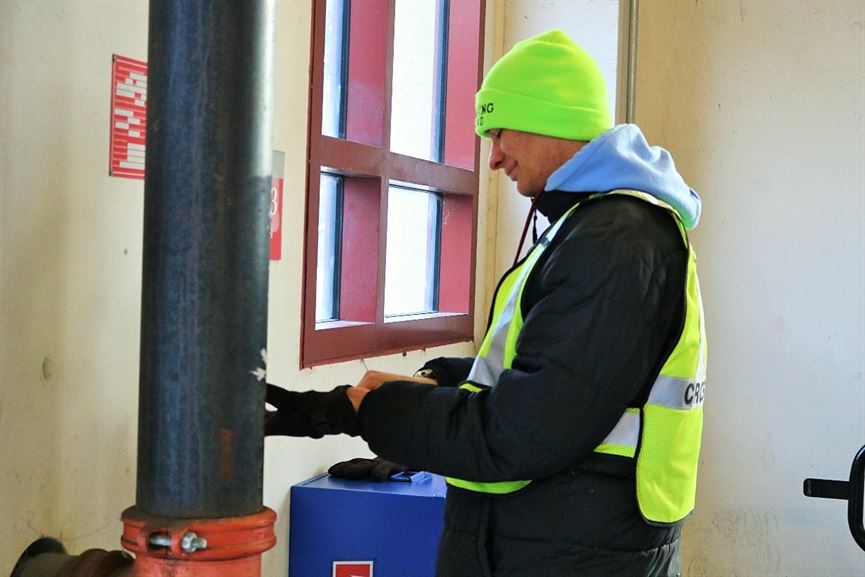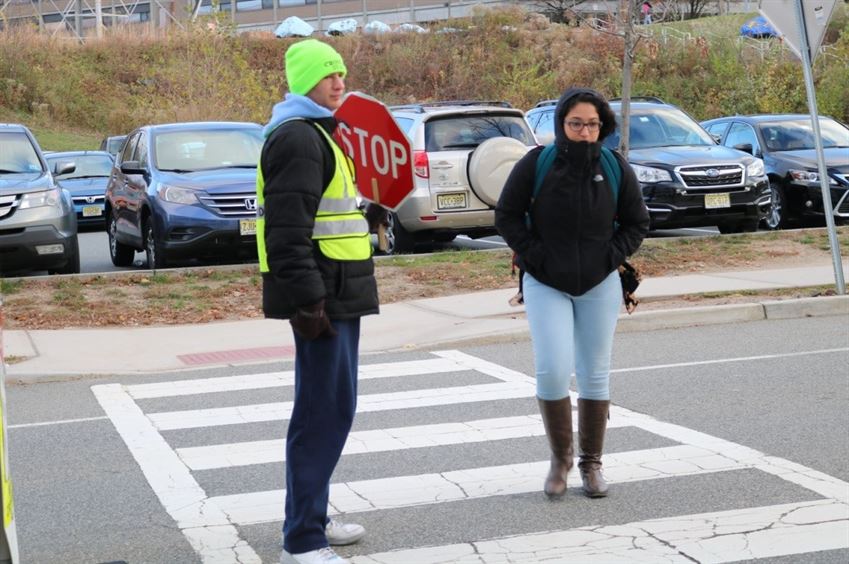
Mario Papa, a sophomore majoring in television, digital, media , preparing for work as a crossing guard. Photo by: Adrianne Natoli
In November, the clocks “fell back,” marking the start of daylight saving time. That meant at 5:30 p.m., it was dark. Without the sunlight, it wasn’t only dark, it was cold.
Mario Papa wears a yellow wool hat pulled down closely over his ears and a yellow safety vest given to him by the Montclair State police department. He was told that insulated gloves are on order. For now, he uses his own.
It’s 3:20 p.m. and sunlight is still ricocheting its warmth off the garage and surrounding concrete buildings. In 10 minutes, he will begin his two hour shift as a campus crossing guard.
His primary responsibility as a crossing guard is to keep pedestrians safe by easing the flow of traffic along Yogi Berra Drive.
“[Police] tell us, count 10 to 15 cars,” he said, “then stop traffic.”
The campus crossing guard program is under the direction of the University Police Department. It began as a safety initiative in December 2015 and began its first full year of operation in September 2016.
An earlier article in The Montclarion reported that “the Crossing Guard position is a non-sworn, civilian position and shall not have any law enforcement powers. The crossing guard shall be under the supervision and direction of the Chief of Police and shall be trained.”
That was the job Papa, a sophomore majoring in television and digital media, applied for. Since September, he has worked for six hours a week at $10 an hour.
Normally, he and his partner are stationed at the corner of CarParc Diem on Yogi Berra Drive. He stands in front of the parking garage and his partner directly across, on the opposite side of the street.
Not today. His partner called out, so Papa is working alone. He is quick to say he doesn’t mind. He enjoys the work.

Mario Papa, Sophomore and television digital media major stops traffic to help pedestrians to cross the street. Photo by Adrianne Natoli
Luckily for Papa, there is very little pedestrian or vehicle traffic for the first half hour.
“Probably due to students going home for the [weekend],” he said.
At around 4 p.m., the traffic started to pick up. It is not always possible to keep traffic within the crosswalks. After the 4 p.m. hour, more students crossed outside of the crosswalk on the approach to CarParc Diem.
“When there is a decent enough gap, then I’ll decide to stop [pedestrians] and let the traffic flow,” said Papa. “Sometimes people walk outside of the crosswalk. There is nothing you can do about it.
As long as they cross when you say it’s ok to go, it’s alright.”
Other pedestrians do not listen. Not listening to the crossing guard is a potential safety hazard. On occasion, the pedestrians are halfway across the street and the traffic is moving.
“There is always going to be people like that,” Papa said. “One woman was getting ready to cross and I literally threw my arm out to prevent her from crossing the street.”
Papa went on to explain that sometimes the cars don’t see you. He wears the yellow safety gear, so he feels confident the drivers should see him after the sun goes down, whether or not they turn on their headlights.
“There are people who are always on their phones while driving. They don’t pay attention to the traffic,” Papa said.
He noticed some drivers have the phone in their hand, or on their lap, so when he beckons them onward, they don’t see him and traffic begins to back up. When drivers look up, then they speed up.
Pedestrians at the curb start to get restless. There is no recourse but to clear up the traffic.
Student Naya Hodge said, “I prefer the crossing guards, because they force the cars to stop.”
“I think [having] crossing guards is a good idea,” said Archana Prasad, a first year graduate student.
Yet, not everyone respects the crossing guards. Some drivers use the middle of the crosswalk as a drop-off site. The crossing guard can’t cross pedestrians while a vehicle is in the crosswalk.
“That bothers me,” said Papa.
Despite the challenges the job poses, Papa likes his job and the comradery he and his co-workers share.
“Mario is my favorite co-worker,” Asyra Muchison, a senior psychology major, said with a huge grin on her face. “I like working with him so much.”
“The more you work it,” said Papa, “the more you see the same people.”
Papa greets pedestrians with a, “Good Morning,” or “Have a good day,” or “Drive safely.”
He said, “It may actually make them feel good about themselves. That’s how I see it.”


